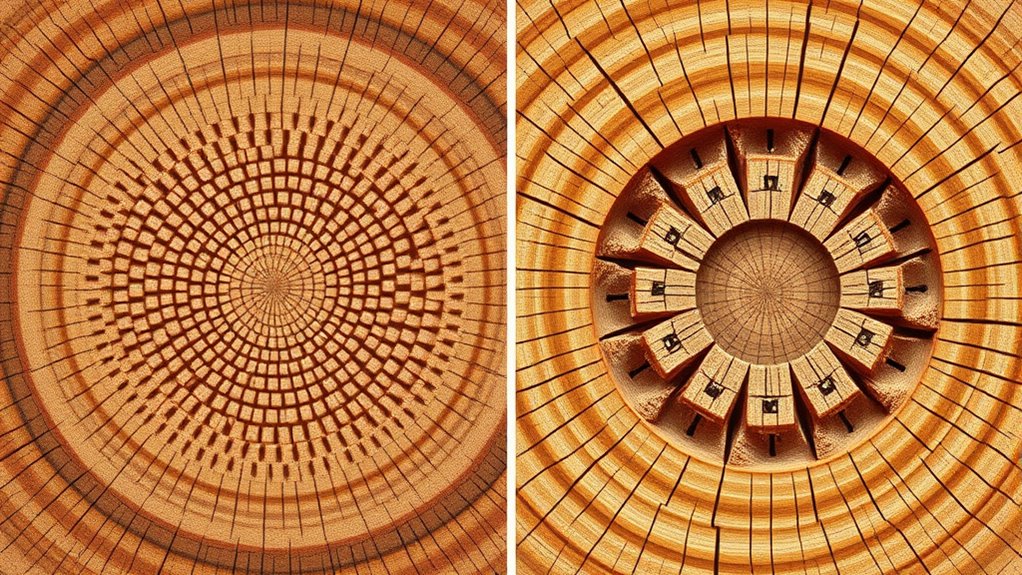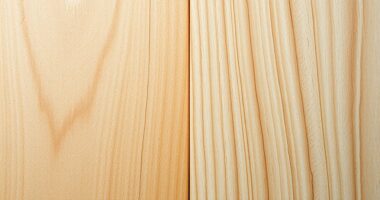Understanding the difference between diffuse-porous and ring-porous woods helps you choose the right type for your projects. Diffuse-porous woods have vessels evenly spread throughout the growth rings, giving a uniform appearance and easy workability, like maple or cherry. Ring-porous woods have large vessels concentrated in earlywood, creating visible rings and a dramatic look, as found in oak or walnut. Want to learn more about their specific uses and characteristics?
Key Takeaways
- Diffuse-porous woods have vessels evenly distributed throughout the growth ring, resulting in uniform texture and appearance.
- Ring-porous woods feature large vessels concentrated in earlywood, creating prominent growth rings and visual contrast.
- Species classification: diffuse-porous includes maple and cherry, while ring-porous includes oak and ash.
- Diffuse-porous woods are easier to work with and produce smooth finishes; ring-porous woods are often stronger but more prone to cracking.
- Recognizing growth patterns helps in selecting appropriate wood for aesthetic, structural, and workability considerations.

When choosing wood for your project, understanding the differences between diffuse-porous and ring-porous woods is essential. These classifications hinge on the growth patterns and vessel distribution within the wood, which directly influence properties like appearance, workability, and how the wood responds over time. Recognizing these differences helps you select the right material for your specific application, whether it’s furniture, flooring, or decorative pieces.
Understanding diffuse-porous and ring-porous woods is key to choosing the right material for your project.
In diffuse-porous woods, the growth pattern features vessels that are evenly distributed throughout the growth ring. This means the vessel distribution is fairly uniform from the earlywood to the latewood, resulting in a consistent appearance. As a result, diffuse-porous woods tend to have a more homogeneous texture, with vessels that are usually small and evenly spaced. This pattern is typical in species like maple, cherry, and birch. Because the vessels are dispersed evenly, these woods generally exhibit uniform density and color, making them easier to work with and finish. They usually don’t show prominent ring patterns, which can be advantageous if you want a smooth, consistent surface.
In contrast, ring-porous woods display a different growth pattern. Their vessels are concentrated in the earlywood, which forms at the beginning of each growth ring. This results in a vessel distribution that’s denser and larger at the start of each ring, creating distinct, visible rings when the wood is cut across the grain. These large vessels give ring-porous woods a more dramatic appearance, with pronounced contrast between the earlywood and latewood. Species like oak, ash, and walnut are typical examples. The vessel distribution in ring-porous woods influences their strength and durability, often making them suitable for heavy-use furniture and flooring. However, the larger vessels can also make these woods more prone to cracking or splitting if not properly handled. Additionally, understanding growth patterns can help predict how the wood will age and respond to environmental changes.
Understanding the growth patterns and vessel distribution helps you anticipate how the wood will behave and look. Diffuse-porous woods tend to have a more uniform appearance and work well for projects requiring smooth finishes. Ring-porous woods, with their prominent rings and larger vessels, provide visual interest but may require more careful handling during cutting and shaping. By grasping these fundamental differences, you can make informed choices that suit both the aesthetic and structural needs of your project, ensuring better results and longevity of your finished piece.
Frequently Asked Questions
How Does Wood Porosity Affect Its Acoustic Properties?
You’ll notice that wood porosity influences its acoustic resonance and sound absorption. More porous woods tend to absorb sound better, reducing echoes and creating warmer acoustics. Dense, less porous woods often produce clearer, sharper sounds because they reflect more sound waves. By choosing the right porosity, you can optimize your space’s acoustic environment, whether you want to enhance resonance for musical instruments or minimize echo for better speech clarity.
Can Wood Porosity Influence Its Resistance to Pests and Decay?
Yes, wood porosity can influence its resistance to pests and decay. Dense, less porous woods tend to offer better pest resistance because they’re harder for insects to penetrate and feed on. Conversely, more porous woods may be more susceptible to decay since moisture can penetrate easily, promoting fungal growth. Choosing the right porosity level helps you improve durability, making your wood more resistant to pests and decay over time.
Are There Specific Tools Best Suited for Working With Each Wood Type?
You should pick tools suited to each wood type, as different woods call for different approaches. For diffuse-porous woods, use fine-tooth saws and sharp chisels to avoid tearing fibers, while ring-porous woods benefit from more robust tools like framing saws and heavy-duty planes. Your tool selection and cutting techniques are the keys to smooth results—don’t bite off more than you can chew, and work accordingly.
How Does Porosity Impact the Environmental Sustainability of Wood?
Porosity influences environmental sustainability by affecting how efficiently wood can be harvested and reused. You can promote sustainable harvesting by choosing less porous woods, which often require fewer resources to process. Additionally, porous woods, especially ring-porous types, sequester more carbon over time, helping combat climate change. By understanding porosity, you make eco-friendly choices that support sustainable use and maximize the carbon sequestration potential of wood resources.
Are Diffuse-Porous and Ring-Porous Woods Used for Different Applications?
Think of diffuse-porous and ring-porous woods as different musical instruments, each suited for specific melodies. You use ring-porous woods for bold, striking projects because their prominent grain pattern offers strong aesthetic appeal, perfect for furniture and flooring. Diffuse-porous woods, with their uniform grain, excel in delicate, detailed work such as veneers and interior trims. Their unique grain patterns guide your choice based on the desired visual impact and application.
Conclusion
Now that you’ve glimpsed into the world of diffuse-porous and ring-porous woods, imagine walking through a forest where each tree whispers its secrets through its structure. Recognize how these differences shape not just their appearance but their strength and uses. Like a master artist choosing the perfect brushstroke, understanding these woods lets you appreciate their unique beauty and purpose. Embrace this knowledge, and watch your appreciation for nature’s craftsmanship deepen, revealing its hidden artistry.









